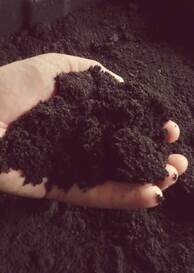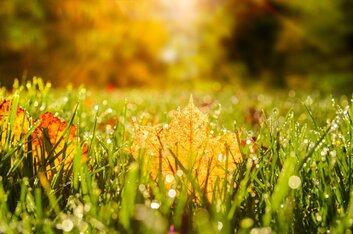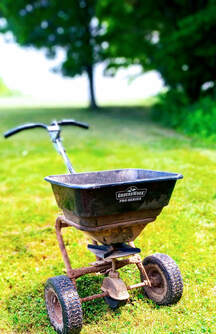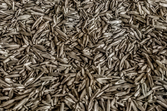 Want to water your garden less, even in the driest months of the year? Want to know that your garden's soil can hold onto the nutrients you apply in the form of fertilizer? Then you need to put down some vermicompost, also known as worm compost or worm castings. Before I get into the amazing benefits of Worm Compost, I just want to say that putting down any compost will help your soil hold onto water better. If you've got sandy soil, adding organic matter (compost) will help keep water from running right on through. Even if you've got loamier soil, organic matter will provide HUGE benefits to your garden, especially helping it to hold onto water longer. All that being said, we've found that the best type of compost for gardens is the compost made by worms-- Worm Compost. Not only does it lock water into your soil, it has beneficial microbes from the worms' digestive tracts that will help your garden flourish, both as a mild fertilizer and a disease suppressant. According to a study at Cornell University, it's been "shown that beneficial microbes in vermicompost can colonize a seed's surface and protect it from infection by releasing a substance that interferes with the chemical signaling between the host and the pathogen." To buy some of our amazing Living Worm Compost, click here. Free local delivery in West Michigan (Kent, Ottawa, Allegan & Muskegon Counties).
0 Comments
 Overseeding your lawn is a really important part of having a thicker, healthier and greener lawn with less weeds. It really isn't difficult to do, but it does require some knowledge to get the most germination for your buck. Read on to learn the why, what, how, when and where of overseeding your lawn. Keep in mind, we're a West Michigan-based company, so our recommendations are targeted for this region. Where should you overseed your lawn? It doesn't take much space for a weed to sprout. Nature hates any empty space, so if there's a bit of soil showing, there's a good chance something's going to pop up there. You may not even see that empty space-- it could be as small as a quarter on your lawn-- but it's there. That's why it's important to overseed your entire lawn, every single year. Cover it, from corner to corner, with a sun/shade mix of grass seed. Follow the application instructions on the bag; don't put down more than the recommended rate (typically, for a sun/shade mix, 2.5 pounds for 1,000 square feet of turf). If you're patching a bare spot, don't cover the entire space with seed, sprinkle it like you're seasoning a steak. Remember that grass spreads and more isn't better when it comes to grass seed.  Overseeding your lawn is a really important part of having a thicker, healthier and greener lawn with less weeds. It really isn't difficult to do, but it does require some knowledge to get the most germination for your buck. Read on to learn the why, what, how, when and where of overseeding your lawn. Keep in mind, we're a West Michigan-based company, so our recommendations are targeted for this region. When should you overseed? The short answer: either the spring or late-summer/early-fall. Late-summer/early-fall is ideal, however. The longer explanation is that the grass that grows in Michigan is called "cool weather turf." That means it grows best in cool temps-- when daytime air temperatures are between 60 and 75 degrees. (I like to call this "open window weather," when you need neither your furnace nor air conditioner to make your house comfortable.) When temps drop below 60 for an extended period (late fall & winter), the grass goes dormant. When temps rise above 75 for an extended period (summer), the grass also goes dormant. Winter and summer are terrible times to put down grass seed in Michigan; the seeds just will not germinate. So the ideal time is to put down seed in the late-August to mid-September. This is when the nighttime temperatures start dipping into the 50s again, which will help lower the soil temp to an optimal point for seed germination. Fall is also a great time to overseed because of the life cycle of annual lawn weeds. Annual lawn weeds germinate in the spring, drop their seed in the summer, and die off in the fall. If you can put down some grass seed in late summer or early fall, it'll have time to germinate before winter. This will help fill in gaps in your lawn, so next spring when those weed seeds are looking for a place to sprout, you'll already have grass growing there. While fall is ideal for overseeding, you can also do it during the spring growing season (typically late April to late May). The competition for nutrients, water and space is just a bit more fierce in the spring. Fall and spring are also the time to pull up weeds (or, if you absolutely must, put down an herbicide). If you're removing weeds from your lawn, you're typically opening up a space on your lawn as well. Now is the time to do the overseeding, so that grass will fill that gap instead of a new weed. Something is going to grow in that gap-- let's make it grass.  Overseeding your lawn is a really important part of having a thicker, healthier and greener lawn with less weeds. It really isn't difficult to do, but it does require some knowledge to get the most germination for your buck. Read on to learn the why, what, how, when and where of overseeding your lawn. Keep in mind, we're a West Michigan-based company, so our recommendations are targeted for this region. How should you overseed? When overseeding your whole lawn you should follow these practices: 1. Mow your lawn the day of or the day before you overseed, and set your mower a notch or two lower than you normally mow at (not the lowest or second-lowest settings; you'll scalp your lawn). You should also either bag the clippings or rake up as many clippings as you can before putting the seed down. Now both of these practices (mowing shorter and removing the clippings) go against my normal recommendations, but there's a reason for it. Mowing the grass shorter than normal allows the seed to move down to the ground easier. It also allows you to go a little longer before you need to mow again so you're not sucking up the baby seedlings. Removing the clippings from the lawn before overseeding also helps the seed work their way down to the soil easier. 2. Using a push spreader or hand spreader, apply the grass seed mix just as you would fertilizer, in even rows, in a snaking motion across your lawn. It's best to do it on a calm day, when the grass is dry. 3. Water immediately for 20-30 minutes. Then for the next 14 days, water daily for about 10-15 minutes in the morning. If it's an especially warm day (80-degrees or more), you might want to do another 10-15 minute watering in the evening. Short daily waterings aren't normally recommended for your lawn, but think about these seeds as babies-- they need constant help from you until they grow roots and can find water on their own. Until these seeds germinate and grow to about 1/2-inch tall, you need to give them water every day. The soil must remain damp for the first two weeks, or the seeds won't sprout, and if the new seedlings have sprouted, they'll whither and die. 4. After about 14-20 days, feel free to mow again. This may mean letting your lawn get a little shaggier than it normally looks, but tough it out so that your new grass has a good chance to germinate, take root and begin its new life on your lawn. Basically, go as long as you can before mowing again. But what if you've got larger patches in your lawn where grass just doesn't seem to do very well? You've tried seeding there before, only to have it not germinate or, if it does germinate, die off shortly after. Or maybe you've got areas where pets have killed the grass with their urine. This could mean you've got bad soil there. I'd recommend putting down some organic matter-- a compost/topsoil blend would be good. Even better than that, we sell a blend called Lawn Soil, which we've been using for a few years now with amazing results. It's specially formulated to help seeds germinate quickly and new grass to be thick and lush. Once you've put down some organic matter on the area, you can overseed as recommended above.  Overseeding your lawn is a really important part of having a thicker, healthier and greener lawn with less weeds. It really isn't difficult to do, but it does require some knowledge to get the most germination for your buck. Read on to learn the why, what, how, when and where of overseeding your lawn. Keep in mind, we're a West Michigan-based company, so our recommendations are targeted for this region. What type of seed should you overseed with? Simply put, you need to put down a sun/shade mix of grass seed. You can buy this type of mix in most stores. You can also buy it right on our website; this is what we've been using for our own lawn and recommending to our customers for years. Don't waste time trying to figure out if you need fescue or ryegrass or bluegrass. Just put down a sun/shade mix over your whole yard, and let nature sort it out. The shade-loving varieties will germinate in the shady areas, the sun-loving varieties will germinate in the sunny areas. I'm also a big fan of Dutch white clover, and you should be too! You could also put down some clover seed to fill in gaps where grass struggles to take hold. We sell that too. |
